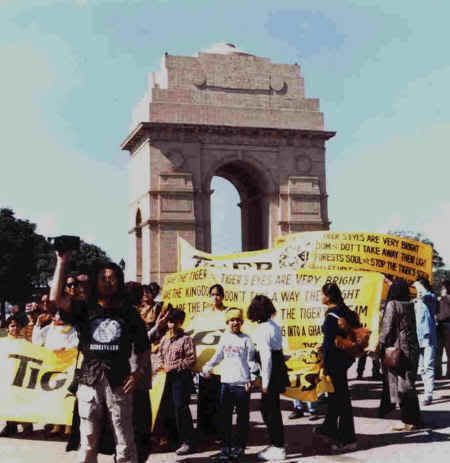
My third trip to India, in 1999, was in a way the most memorable of the three. Due to the 20-country exposure by Champions of The Wild, Bandhavgarh National Park, and to a lesser extent Kanha National Park, received global attention, and I was given the hero's welcome at both tiger reserves, with great fanfare, by the villagers as well as the park officials.

The officials at Bandhavgarh organized two events in my honor. First was an informal film night where, under the stars and the towering trees, we showed the Champion of the Bengal Tiger on a large white wall, after which Faiyaz and I gave our bilingual slideshow. The square was jammed full of villagers and officials alike, while the surrounding landscape was alive with fireflies. I would have loved to hear the distant roar of a tiger, but all was quiet on the eastern front.

The second event was a formal tiger conference, where I was honored as the keynote speaker.
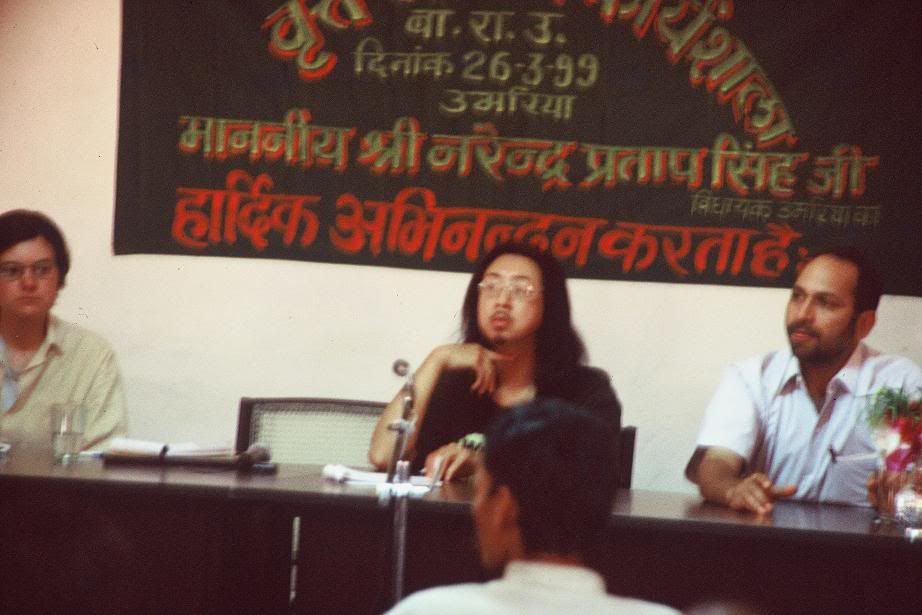
The chieftains of well over 60 villages participated, over 40 of whom signed up for a solar cooking and biogas program. The purpose was to reduce and eventually eliminate wood-cutting for fuel and alleviate deforestation.

Anti-poaching is of course always on the agenda.
Speaking of which, my visit at Bandhavgarh did not open on a positive note. Upon my arrival at the tiger reserve, I and my volunteers Anne, Kim, Christopher and Chris were greeted by a mournful and even tearful park staff. The tigress Sita, whom all loved, had been killed by a poacher, and two of her cubs had also disappeared. Charger was still there, but we had begun to greatly fear for his safety.
Upon my return to Kanha, I was again surrounded by village children, and I took small groups of them into the park as often as I could, and played soccer with them maybe once a week.
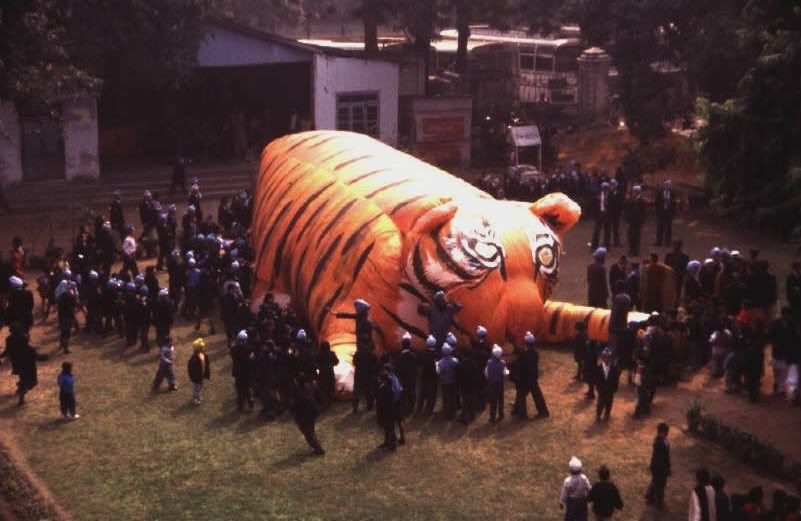
I also spent about 3 weeks lecture-touring urban India, including New Delhi, Jaipur and Jabalpur, and everywhere I went, I was treated with a welcome so effusive it was unmatched by any I have received from elsewhere in the world. I mean, it wasn't every day that some long-haired, alien-looking, Chinglish-speaking, army-boots-wearing "Champion of Tigers" come sauntering into their school inciting the kids to animal rights activism.

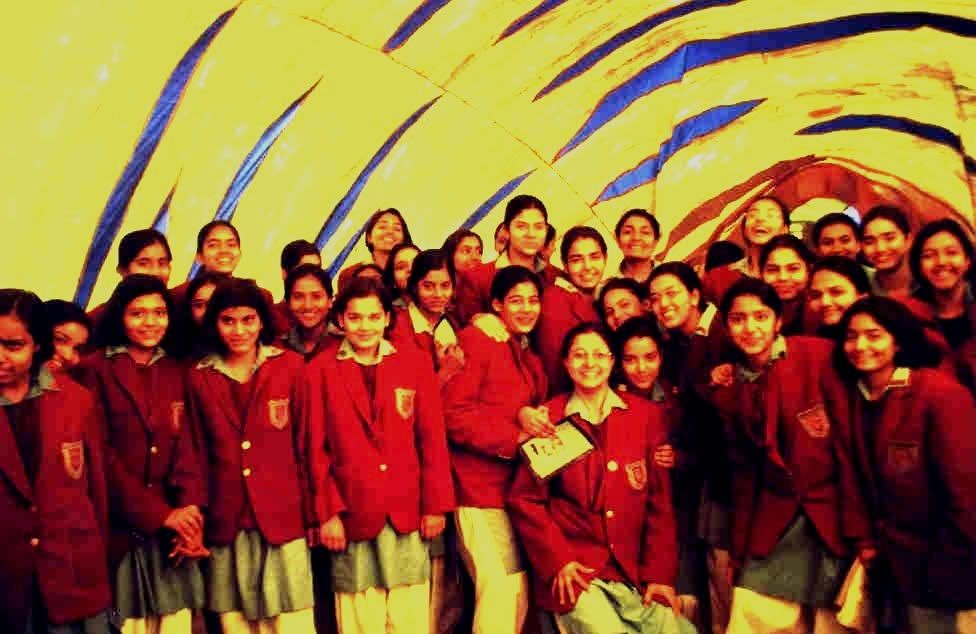

Formation of another tiger club
In a country like India, it is easy to reach millions in one go. While in New Delhi, on February 14, we organized the Love The Tiger Walk, in which some 2000 people participarted.

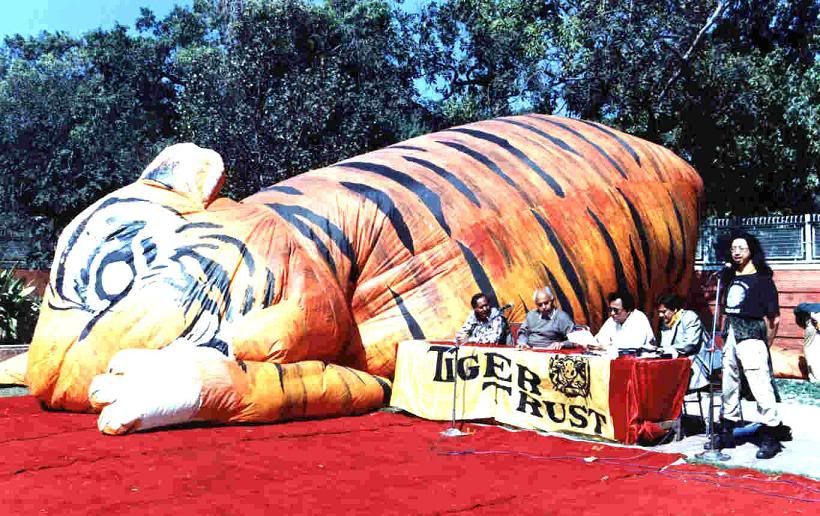
Would you believe that 50 newspapers attended the event, including the monumental Times of India and the colossal Hindu Times? 30 newspapers covered a media conference inside our 50' inflatable tiger in Jaipur. Likewise the Bandhavgarh tiger conference. This trip could have spread the word to 10 million people, maybe even 100 million.
1999-02 Travel Talk magazine, India TT Bureau
[Save the Tiger campaign]
"… ‘A conscious effort has to be made to make the villagers aware of the hazards of deforestation, overgrazing and poaching, and their consequences on the whole ecological balance,’ said Marr.
"His Save-the-Tiger campaign has introduced new eco-friendly techniques for resource conservation, like solar cooking devices and biogas to wean the villagers from their dependence on wood-fuel…
"Marr also feels that the entry fee to the Indian wildlife sanctuaries should be raised manifold to benefit the locals of the area and also to maintain the reserves…"
1999-02-12-5 The Hindu, national, India
[Need to protect tigers stressed]
"… Mr. Marr, who is of Chinese extraction, is apologetic about the role of his country of origin in making the tiger a haunted animal… The Chinese make medicines out of tiger parts and, in the process, import as many as 300 dead tigers from India and Russia a year…
"Owning up to his birth country is the penitent Mr. Marr when he says that he is paying the penalty for his countrymen by campaigning (against the Chinese tradition)…
"… In the Pink City (Jaipur), Mr. Marr lectured to 2500 school children in three schools. In Delhi, he had a captive audience of children in 10 schools. He is convinced that children are India’s hope for its national animals the tiger…"
1999-02-14-7 The Asian Age, India
[Tiger walk today to save wild cats]
"… According to official estimates… tiger numbers have dwindled from 3,750 in 1993 to 3,000 in 1997. After the initial success of Project Tiger, the 90s have seen a drastic fall in tiger numbers. The tiger population in reserves around the country stands at 1,333 in 1995…"
1999-02-15-1 The Statesman, India
[A valentine for the big cat]
"An unusual ‘Valentine Day’ message was displayed by tiger enthusiasts in the Capital who went on a brisk march from Delhi Zoo to the head quarters of Project Tiger at Bikaner House, to spread the message of conservation.
"Children and adults held up banners for the ‘Love Tiger Walk’… (Organizers) pointed out that the largest cat n the world today has a mortality rate of two per day in the world and one per day in India alone.
"‘Especially as a tigress does not have another litter till her young can support themselves, ‘it is so much necessary to support the ones which are alive, as they do not breed rapidly like other species,’ said a child who participated in the march.
"A video show, an inflatable tiger blimp and presentations by eminent conservationists were some of the features of the march, which was supported (in part) by the WCWC."
1999-02-15-1 The Indian Express, India
[Tiger, tiger burning bright]
"A tiger balloon at the Love the Tiger Walk at the Delhi Zoo on Sunday…"
1999-02-15-1 The Hindu, national, India
[Valentines tiger lovers]
"… A team comprising Mr. Anthony Marr, campaign director of WCWC… has been making slide presentations, holding video shows and having interactions inside a 50-feet inflatable tiger balloon…
"They have been received with great enthusiasm by more than 5,000 students of various age groups. Painting competitions and slogan contests have also been organized as part of the campaign…"
1999-02-15-1 The Pioneer, national, India
[‘Save Tiger’ walk]
"Wildlife lovers walked through the busy streets of the national Capital on Valentine’s Day on Sunday to show their love for the tiger, which faces the threat of extinction…"
1999-02-15-1 The Hindustan Times, national, India
[Save the tiger]
"A 50-foor balloon tiger at the National Zoological Park to generate awareness among the masses for the conservation of the tiger…"
1999-02-16-2 Delhi Times, The Times of India, national
[He is no ordinary tiger]
"They sit inside it and discuss its decimation from the face of the planet. It’s 50-foot long and 12-foot high and is made of parachute material that can inflate. Striped bright yellow and black, this tiger was (brought to India) by WCWC for a Save-the-Tiger campaign to generate awareness on tiger conservation amongst school children…"
1999-03-18-4 The Hitavada ("The oldest and largest circulated English daily in Central India")
[Save tigers from extinction: Marr - Great mission: Anthony Marr educating children about protecting the majestic and beautiful tiger]
"… Mr. Marr who is tirelessly working in India… said that the tiger is the greatest national treasure of India, but even more so, it is a global treasure that is revered the world over. ‘Though it belongs to no individual, its loss would impoverish us all.’…
"… Mr. Marr said that the Royal Bengal tiger might look the most secure of all remain subspecies, but in truth, it is no more secure that the last carriage of a crashing train…
"Currently, Mr. Marr, along with (Canadian volunteer Anne Wittman) and… (Indian conservationist) Faiyaz Khudsar are battling to educate the people living around the Kanha (Tiger Reserve)…"
1999-05-10-1 The Vancouver Sun by Alex Strachan
[Rupert’s Land, Discovery shows win early Leos]
"… In television awards, Andrew Gardner won best writing in an informational series for a segment of Champions of the Wild featuring conservationist Anthony Marr and his efforts to draw attention to the plight of India’s Bengal tiger. Champion’s cinematographer Rudolf Kovanic was also cited for a segment about elephants…"
1999-6 TigerLink, India, global
[Love the Tiger Walk, Delhi]
"…The participants chanted slogans and sang a tiger conservation song lead by Mr. Anthony Marr, Tiger Campaign Director, WCWC…
"At Bikaner House the gathering was addressed by Mr. P.K. Sen, Director of Project Tiger, Mr. S.C. Sharma, Addl. Inspector General Forests (Wildlife), Angarika Guha, Class III student from Sri Ram Public School, Mr. Anthony Marr and Mr. Pradeep Sankhala, Chairman of Tiger Trust…"
1999-06-02-3 The Daily New, Nanaimo, BC by Valerie Wilson
[Students learn plight of the tiger]
"… Anthony Marr… warns tigers are disappearing at al alarming rate. He is in Nanaimo this week to ask area school children to save the tiger from extinction.
"‘Your voice is important and you must speak out,’ Marr told students of Uplands Park Elementary Tuesday. ‘You are very powerful if you want to make some changes in the world.’
"Marr has been back in BC for about a month, after a 10 week working stint at tiger reserves in India. He brought home with him a breath-taking slideshow of the country’s landscape, tree and plant life, birds and animal life, and of course, photographs of the tiger he viewed at India’s Kanha, Bandhavgarh and Ranthambhore tiger reserves.
"‘A question I am asked often by adults is there are no tigers in Canada, so why should we be bothered.,’ Marr told student.
"‘Very simply. The tiger is one of most beautiful animals in the world. If it becomes extinct, our world would be much less beautiful place. We all lose.’.."
1999-06-07-1 Nanaimo News Bulletin by Erin Fletcher
[A tale of 4,000 tigers]
"Children hold the key to the survival of the endangered tiger, says tiger conservationist Anthony Marr…
"To spread the word about the plight of tigers, Marr was visiting Nanaimo schools last week with a slideshow presentation, video, and a discussion in the hopes to stimulate an interest in tiger preservation among local youth.
"Marr has been involved with tiger conservation since 1994. His passion takes him into the depths of India where he works to educate and promote the preservation of tigers…"
1999-06-10-4 Nanaimo News Bulletin by John Kimatas
[Chamber picks city’s top citizens]
"… Having won a scholarship this year, (Madeline) Hargrave says she’ll probably study at Malaspina University-College for a year. But after hearing Anthony Marr speak at a Global Watch function about the plight of tigers in India, she’s considering traveling to India to help him save the tiger.
"Otherwise, she is unencumbered by limitations. ‘I want to do everything,’ she says."
1999-08-02-1 Associated Press, New York City by Katherine Roth
[Despite tougher laws, tiger bone still widely available in Chinatown]
"… As of Monday, the products were still prominently displayed on the shelves of some pharmacies and grocery stores (in New York City's Chinatown)…
"‘It’s very popular and is good for people with bad backs,’ a smiling clerk at Kam Man Food Products on Canal Street told shoppers on Monday. ‘I don’t take it, because I don’t have a bad back, but a lot of people do,’ said the man, who declined to give his name or comment further…
"Anthony Marr… said that of the 37 traditional Chinese pharmacies visited in Chinatown recently, nine were openly selling products listing tiger bone as an ingredient. He is calling for stiffer penalties for sellers and importers who break the law…
"But the US Fish and Wildlife Service… says it doesn’t have enough resources to stop the brisk trade…
"‘We have 93 inspectors and 230 special agents for the entire country. They’re stretched pretty thin,’ said Patricia Fischer, a spokeswoman for the agency. ‘The sheer volume of wildlife products coming into this country present a monumental task…’
More than 50,000 over-the-counter tradition Chinese medicines containing, or purporting to contain, tiger bone and parts from other critically endangered species are sold in the United States each year to people of all ages and ethnic groups…"
1999-08-03-2 Daily News, New York City by Laura Seigel
[Tiger bone Rx selling in the city despite ban]
"At a cramped grocery in Chinatown yesterday, a casually dressed man plunked down $3.95 and was handed an alleged arthritis cure - tiger bone bills.
"Anthony Marr, the Chinese-Canadian tiger campaign director of WCWC in Vancouver, said the purchase proved a grim fact that he had traveled to New York to demonstrate:
"The law against selling medicine made from the bones of tigers, an endangered species, is not being enforced.
"‘I’m here in New York to persuade the government to enforce the law,’ said Marr. ‘Tigers will be extinct within 10 years unless things change.’
"A spokeswoman for the federal Fish and Wildlife Service, which is responsible for monitoring the sale of tiger bone medicine, conceded the agency could do a better job. ‘But we don’t have the staff,’ Patricia Fisher said. ‘We only have 230 special agents for the entire country.’
"She said the agency has tried to control the sale of tiger bone by teaching Asian communities about endangered species, rather than by enforcing the law without explaining it. ‘This is a tradition in Oriental medicine that goes back centuries,’ Fisher said…"
1999-08-03-2 World Journal (Chinese), global
[The ‘Long March’ of a Chinese-Canadian conservationist]
"… Marr arrived in New York City last Friday. On Saturday, he conducted a reconnaissance of Manhattan’s Chinatown district with some local help. In one sizzling afternoon he investigated 37 medicinal stores, and found at least nine that still openly displayed tiger bone medicines for sale…
"Yesterday, after a brief media conference in which Marr gave a slideshow on tiger conservation, he led the media present to three of the nine stores to perform demonstration live-purchases…’
"Shop keepers interviewed seemed aware of the illicit nature of the product, but said since most tigers in China have been killed off, the tiger bone medicines they sell probably contain no real tiger ingredient…
"The new Rhino and Tiger Product Labeling Act of 1998, however, ban any product claiming to contain tiger or rhino parts, whether or not they actually do…"
1999-08-12-4 Reuters News Agency by Manuela Badawy
[Import of tiger bones a problem in U.S.]
"…’At today’s rate of poaching tigers will be extinct in a decade. Tigers don’t have the time to wait for the Chinese community to change its habit,’ said Marr, who is of Chinese descent and has taken heat from other Asian for his campaign.
"On a recent day, he led journalists to New York’s Chinatown, which has one of the largest concentrations of people with Chinese background in the United State, to buy supposedly banned tiger elixirs.
"At the Golden Spring pharmacy on the Bowery in Lower Manhattan, Marr walked right in and bought a vial of Tiem Ma tiger bone pills for $3.95. Tiem Ma pills, made by Guiyang Chinese medicine factory in China, listed 6.8 percent ground tiger bone as one of its ingredients and claimed to treat rheumatic neuralgia, lassitude of tendon and back pain.
"When journalists and photographers went into the store after Marr purchased the pills, clerks became visibly anxious, removing the pills from the counter and shoved them into a box. They refused to answer journalists’ questions…"
1999-08-21-6 The Toronto Star by Manuela Badawy, Reuters
[A helluva town for tigers]
"… Under the 1998 Rhino and Tiger Products Labeling Act …people caught with these products face a fine of $5,000. Business owners pay $10,000 and/or get six months in jail.
"In comparison, fines for seal penises are $100,000 for individuals and $200,000 and/or one year in jail for business owners.
"Marr says the fines for tiger violations should at least equal that for seal violations, if only because the tiger is critically endangered…"
---------------------------------------------------------
1999-05-14
Vancouver Sun
A Passionate Journey to Save India's Tigers
By Anthony Marr
VANCOUVER, British Columbia, Canada, May 14, 1999 (ENS) - The tigress was sleeping on her side in the undergrowth deep within Kanha National Park in Madhya Pradesh, the self-appointed "tiger state" of India. She was scarcely visible in the dense foliage with her camouflage of brown and white patches and shadowy black stripes. Within tail-flicking distance behind her was a half-eaten carcass of a wild boar. The tigress was not going anywhere, short of angrily bolting in fear of being stepped on by the elephant on which I was ensconced, which was indeed getting a little too close.
She tolerated our intrusion for awhile, but when the elephant ripped a branch off the tree in whose shade she was resting, she finally had enough, rolled on all fours, gave us a chilling glare and emitted a hissing snarl that could not be ignored. I snapped the last of a string of photos and instructed the mahout (elephant driver) to beat a prudent retreat.
It was January this year, during my third expedition to India's Kanha and Bandhavgarh tiger reserves as Western Canada Wilderness Committee's (WCWC) tiger conservation program director. The program, with WCWC working in partnership with the Indian conservation group Tiger Trust (TT), is funded by the Canadian International Development Agency at $100,000 per year over three years. WCWC also generates further tiger conservation funds from its own 25,000-strong membership, hundreds of donors, educational outreach slideshows and its annual Save-the-Tiger Walk.
Of the original 100,000 to 150,000 tigers worldwide, only 4,000 to 5,000 remain with only three of the original eight subspecies surviving. The Bali tiger was extinct as of the 1940s, the Caspian tiger died out in the 1970s and the Javan tiger in the 1980s. Of the remaining subspecies, the Indian Royal Bengal tiger has the best chance of survival because there are still about 2,500 remaining compared with 1,000 Indo-Chinese tigers, 300 Siberian tigers, 300 Sumatran tigers and 20 South China tigers.
Wild tigers are dying at the rate of about two each day worldwide due to the dual cause of direct killing and habitat loss. By the same token, about one a day dies in India. At these rates, no wild tiger will be left anywhere in the world within a decade, and the Indian tiger's security is but that of the last carriage of a crashing train - unless tiger conservation projects everywhere succeed big time, and very quickly. This is what I'm betting on, starting with our Save-the-Tiger Campaign.
In 1973 when Project Tiger was launched, with founder Kailash Sankhala as the first director, tiger trophy-hunting was banned and about 25 tiger reserves were created. Meanwhile, however, consumer countries like Japan, Korea and China continue to demand for more tiger bone and penis to supply their traditional medicine markets, and India's human and cattle populations continue to sky-rocket - 980 million and 300 million today respectively.
These are the dual causes of tiger decline - habitat loss and direct killing. Direct killing refers to poaching for medicinal bone and penis, but also poisoning by villagers in retaliation for the occasional loss of cattle as tiger prey. Habitat loss encompasses deforestation and overgrazing. Currently, the biological contents of a miniscule three percent of India's land mass are given any degree of protection, but even these "protected" areas are being eroded by government-condoned mining and logging, and by local villagers in desperate need of firewood for cooking and heating. Especially hard to solve is the overpopulation problem of India's cattle, caused by their being milk-producers, beasts of burden, and, most importantly, sacred cows.
For each of these problems there are long-term and short-term solutions. The long-term solution is to re-kindle citizen pride in the tiger as a national symbol throughout India and especially to motivate the villagers who live around tiger reserves to become tiger conservationists themselves.
This is easier said than done. While I was there, India was consumed by cricket fever. If Indian tiger conservation could captured but one percent of this enthusiasm, I could retire.
During my two-week stay in urban India, I gave our tiger conservation slideshow, seen by more than 30,000 students in British Columbia, to 3,000 students of ten Delhi and Jaipur schools. The show did generate the same degree of enthusiasm, resulting in ten "tiger clubs," which I aim to link with environmental clubs in schools in Canada.
What does it take to turn villagers into tiger conservationists? Consider first the villagers. During my eight-week stay in rural India, our WCWC/TT team, made up of TT field worker Faiyaz Khudsar, Vancouver volunteer Anne Wittman and myself, held six hour meetings with the leaders of about 120 villages of the 178 in Kanha's Buffer Zone. The meetings included discussion, a slideshow and a two hour safari in the park - a place most of them have never seen.
A sub-species of the Swamp deer - the Barasingha (Cervus durauceli branderi) in Kanha National Park.
Their most common concerns are crop plundering by park ungulates especially the cheetal deer and the wild boar, loss of cattle to tiger, insufficient compensation for both, the lack of irrigation, and, last but not least, the lack of financial benefit from the park.
Underneath these external factors is the general undertone of abject poverty that limits the villagers' mindset to the here and now at the expense of tomorrow into which the path of conservation extends. The key to overcoming these difficulties is actually quite simple: to let long term conservation benefit them today.
One of the key components of this is to introduce alternative
technologies, such as biogas plants and solar cookers, to replace wood as fuel. Bearing in mind that village women currently spend their daylight hours gathering fuelwood from far afield, then walking kilometers back to their villages or to townships to sell their 50 pound headloads for 15 rupees (55 cents) each, they would welcome alternatives that could allow them to stay at home and work on financially more rewarding and more eco-friendly cottage industries.
Our team trekked long distances through thick jungle in Kanha's Buffer Zone to access remote villages with our demo solar oven on one of our backs. The demo cooker was designed and made in Canada, but units are modified in India so they can be constructed out of local materials. With nine months of solid sunshine a year, India is well suited to this technology. In a multi-village conference at Bandhavgarh where I was one of the speakers, we signed up 23 villages who wished to try out our solar cooker, and further, five villagers signed up to learn to make the cooker on a commercial basis.
To combat the cattle overpopulation and overgrazing problem, we bought a special hybrid Haryanna bull that local people had been hankering for - one whose offspring yield ten times the amount of milk as the usual breeds. We provided it on a trial basis to a village named Chichrunpur on the periphery of Kanha tiger reserve - one of the 22 villages translocated from the Core Area into the Buffer Zone during the creation of the park. The villagers agreed to stall-feed the new bull and his offspring with fodder that can be grown on part of the land or obtained commercially, while gradually retiring the existing low quality stock and neutering all their existing random-bred bulls. After a generation two, the bull will be rotated to another village and another installed in his place. Stall-feeding is important because it frees the land from free-range overgrazing, protects the higher-quality animals from tiger predation, and makes cattle dung readily available for biogas (methane) generation - another alternative fuel technology.
Regarding the tiger reserves, the general sentiment of the villagers is that they are little more than rich peoples' playgrounds that provide little financial benefit to them save a few jobs in the park service, and worse, produce deer and wild boar that plunder half their crops without adequate compensation from the park authorities. In view of this, we recommended reforming the park system so that the reserves can at least compensate for themselves. Consider this: the world renowned Kruger National Park of South Africa charges $25 US per visit, Uganda charges US$180 for one hour of Mountain gorilla viewing. Neighbouring Nepal's Chitwan National Park grosses US$800,000 a year. Half goes to improve park services, including anti-poaching, and half goes to a benefit fund managed by the villages themselves, which helps to preserve the park as their benefactor.
In contrast, the Indian tiger reserves charge foreign tourists only US$2.50 for a full day park visit. Indian visitors, mostly wealthy people from other states, pay just 25 cents. We advocate using Chitwan as a model by raising the park fee by a factor of ten for both foreign and out-of-state Indian tourists, while offering local villagers free park access on a limited basis. Half the increased revenue could go to park services which could generate more employment, and half could go to the villages to compensate for crop plundering and finance cottage industry enterprises such as manfacturing solar cookers. This gives the villagers a real control over their own destiny.
The park officials, villagers and tourists we have spoken with at both Kanha and Bandhavgarh by and large wholeheartedly embraced the proposal. We further pointed out that tigers are in fact their benefactors, since they keep the wild ungulate populations down by several thousand a year, and tigers are what tourists from around the world pay the park fee to see.
While at Bandhavgarh, we were dismayed to discovered that the tigress Sita, made world famous by the cover article in the December 1997 issue of National Geographic, had disappeared. Her loss is most likely due to poaching. More than five other tigers out of a supposed population of only 45 have also vanished, all within the last six months. The entire park was in a state of subdued uproar, with fingers pointed in various directions.
Worth more dead than alive
Only yesterday I heard from Faiyaz Khudsar that 10 tiger skins and four tiger skeletons were recently seized in the Kanha District capital Balaghat. Some officials would deny it, but commercial poaching is alive and well at both tiger reserves. The proposed park reform should strengthen their anti-poaching measures.
During our visit, we maintained the medical clinic and free school we installed at the Tiger Trust Conservation Centre at Kanha in 1997. The school and clinic services three nearby villages. In the whole of Kanha's Buffer Zone there are only four medical clinics including our own, all with similar effective ranges. Of the 178 Buffer Zone villages, no more than a dozen have access to any medical service.
For the rest, we introduce local medicinal plant cultivation and use by means of our demonstration medicinal plant garden. We intend to establish a mobile clinic to benefit more villages in due course. From their perspective we are a foreign adjunct to the park system, and they likely would give some credit to the tiger reserves for any benefit they receive from us.
Finally, we can all learn something from India's experience. Tiger trophy hunting was not banned until there were fewer than 2,000 tigers left, in spite of which the Indian tiger may still perish. Currently, most independent biologists agree that there may be as few as 4,000 Grizzly bears in British Columbia, regardless of how many more the prohunting BC government claims there are. If we do not ban the Grizzly bear hunt here in our own backyard immediately, our Grizzly bears may go the same way as the highly endangered Indian tiger, or worse, the extinct Bali, Caspian and Javan tigers.
{Anthony Marr is the tiger campaign director for the Western Canada Wilderness Committee. His next expedition to India will depart from Vancouver in October or November. Anyone interested in volunteering can contact the Wilderness Committee at 604-683-8220.}
@ Environment News Service (ENS) 1999. All Rights Reserved.
* * *
Anthony Marr, Founder and President
Heal Our Planet Earth (HOPE)
Global Anti-Hunting Coalition (GAHC)
Anthony-Marr@HOPE-CARE.org
www.HOPE-CARE.org
www.facebook.com/Anthony.Marr.001
www.facebook.com/Global_Anti-Hunting_Coalition
www.myspace.com/AnthonyMarr
www.youtube.com/AnthonyMarr
www.HomoSapiensSaveYourEarth.blogspot.com
www.DearHomoSapiens.blogspot.com (AM's 3rd-book-in-the-making)
www.myspace.com/Anti-Hunting_Coalition
www.ARConference.org
No comments:
Post a Comment